The Evening Waxing Moon Gets an X, a Bright Comet Shines After Sunset, Maybe Some Meteors, Maybe Some Aurorae, and Definitely Planets!
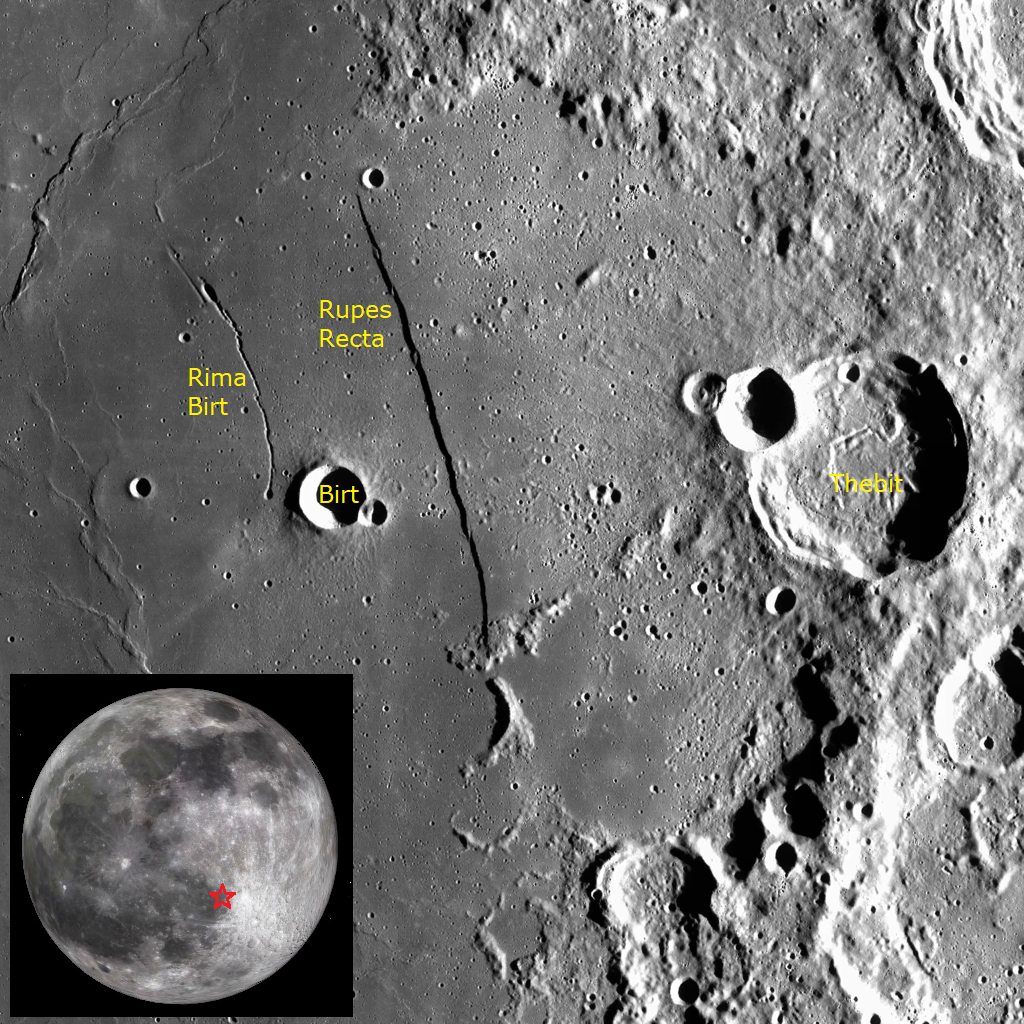
This image of the Lunar Straight Wall or Rupes Recta in Mare Nubium was captured by the Lunar Reconnaissance Orbiter. While the feature can be seen through binoculars, a backyard telescope will reveal more detail. (Adapted from NASA LRO)
Hello, Autumn Stargazers!
Here are your Astronomy Skylights for the week of October 6th, 2024 by Chris Vaughan. Feel free to pass this along to your friends and send me your comments, questions, and suggested topics. You can also follow me on Twitter as @astrogeoguy! Unless otherwise noted, all times are expressed in Eastern Time. To subscribe to these emails please click this MailChimp link.
If you’d like me to bring my Digital Starlab portable inflatable planetarium to your school or other daytime or evening event in Simcoe, Grey, and Bruce Counties, or deliver a virtual session anywhere, contact me through AstroGeo.ca, and we’ll tour the Universe, or the Earth’s interior, together! My book with John A. Read entitled 110 Things to See With a Telescope is a guide to viewing the deep sky objects in the Messier List – for both beginners and seasoned astronomers. DM me to order a signed copy!
The recent new moon controlled the timing of Rosh Hashanah. Now, as it waxes in evening, we can enjoy its sights – including a nice Lunar X event in the Americas. Bright Comet Tsuchinshan-ATLAS will transition to the western sky after sunset, more meteors should appear, and we have six planets to see from sunset to sunrise. Read on for your Skylights!
Aurorae Awareness
The sun continues to eject masses of charged particles that trigger aurorae at Earth’s middle latitudes. But whether they will sweep over the Earth, and when they will do so, is hard to predict. To stay aware of whether aurorae will be visible, monitor sites like Aurora Forecast, or subscribe to an alert service. At the present time, the chance of aurorae at middle latitudes in both hemispheres is elevated for tonight, Sunday, October 6.

Rosh Hashanah
“Shanah Tovah!” to my Jewish friends. In a lunisolar calendar, each month begins at sunset on the new moon, or with the first glimpse of the young crescent moon after its new phase. Nissan 1, the first day of the year in the Jewish lunisolar calendar begins at the new moon closest to the March Equinox in northern spring. The Jewish calendar’s seventh month, named Tishrei, always falls in September or October on the Gregorian calendar. Tishrei hosts the Jewish High Holidays – Rosh Hashanah, Yom Kippur, Sukkot, Shemini Atzeret, and Simchat Torah.
Rosh Hashanah, or the religious Jewish New Year, commenced at sunset on Tishrei 1 (Wednesday, October 2) and will end after nightfall on Tishrei 2. By ending the celebration after nightfall, it spills into Tishrei 3 (October 4), making it a 2-day event – probably because determining exactly when the new moon occurred was difficult before modern astronomical tools. Rosh Hashanah occurs 163 days after Passover, so it is tied to the new moon occuring closest to the September equinox, which fell on September 22 in 2024.
The name can be translated to “Head of the year”. Jews celebrate the creation of the world and mark the beginning of the Days of Awe, a 10-day period of introspection and repentance that culminates with the Day of Atonement, Yom Kippur on Friday, October 11. The traditional greeting during Rosh Hashanah is the phrase “Shanah tovah”.
Comet Tsuchinshan Update
The comet named C/2023 A3 (Tsuchinshan-ATLAS) that I have been telling you about for the past few weeks will be temporarily out of sight while it flies past the sun during the first part of this week. From Thursday onward the comet will appear in the western sky right after sunset. It will increase its distance from the sun by about a palm’s width per day, allowing it to set about 20 minutes later night-to-night and appear in a darker and darker sky.
The comet’s orbital motion will carry it up and to the left, the the celestial east. Without any stars to guide us to it, we’re left with the bright planet Venus to lend a hand. On Friday, the comet will be located 2.7 fist diameters to the right of Venus and slightly lower. On Saturday the comet will shift a palm’s width to the upper left – therefore a bit higher than Venus and a bit closer to it. On next Sunday night the sky will be getting dark enough to see the brighter stars around the comet, which will then be positioned about midway between Venus and Arcturus.
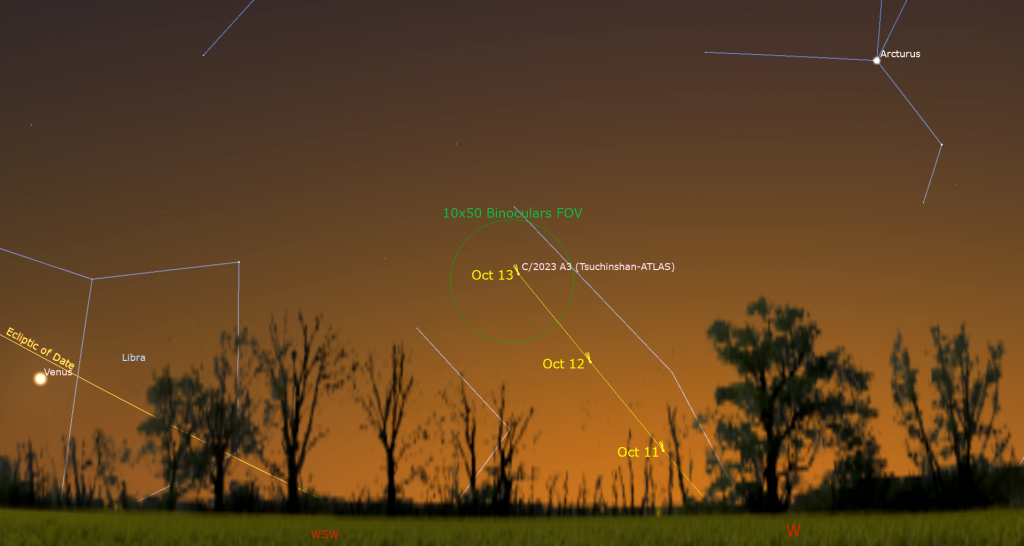
Expect to see a bright little star surrounded by a small fuzzy halo. The slender tail will extend up to the left, away from the sun. Cameras and binoculars will work best. Be sure to keep all of your optics away from the western horizon until after the sun sets. Good luck!
Zodiacal Light Alert
During autumn at mid-northern latitudes every year, the ecliptic extends nearly vertically upward from the eastern horizon before dawn. That geometry favors the appearance of the faint zodiacal light in the eastern sky for about half an hour before dawn on moonless mornings. Zodiacal light is sunlight scattered by interplanetary particles that are concentrated in the plane of the solar system – the same material that produces meteor showers. It is more readily seen in areas free of urban light pollution.
Between now until the full moon on September 17, look for a broad wedge of faint light extending upwards from the eastern horizon and centered on the ecliptic. It will be strongest in the lower third of the sky around the bright star Regulus in Leo (the Lion). Don’t confuse the zodiacal light with the Milky Way, which is positioned nearby in the southeastern sky.
The Moon
This will be the best week of the lunar month to enjoy views of the moon worldwide. Earth’s dance partner will be rising during the daytime and then catching your attention in the southwest as the sky begins to darken. For those of us in the Northern Hemisphere, the sun, moon, and planets are always found in the southern half of the sky, while everyone “down under” will see them in the northwest.
Once the moon passes the sun at new moon, as it did last Tuesday, it sits to the celestial east of the sun and appears in the afternoon and evening sky. While its angle from the sun is still very small, almost all of the sun’s light is falling onto its far side, leaving only a small crescent-shaped section illuminated for us Earthlings. We don’t complain, though – since it’s so pretty!
As the days pass and the moon journeys farther east along its orbit around Earth, the angle between the moon and sun increases by about 12 degrees each evening, or about 1.2 times the size of your fist held at arm’s length. Those larger angles rotate more of the lit hemisphere onto the side of the moon that we see, creating a waxing phase effect. Angles measured east to west on the sky translate directly into time. Since a full, 360-degree rotation of the Earth takes 24 hours, one hour equals 15 degrees (or 1.5 fist widths). Or, put another way, the daily shift to the east of 12 degrees by the moon makes it set 48 minutes later each night – on average.
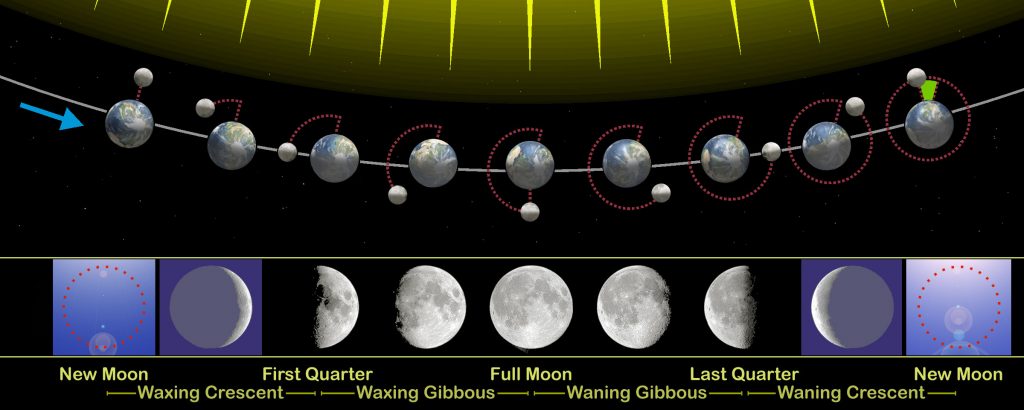
All of that is to say that the moon waxes in phase and stays up longer each night at this time of its month. With the sun setting earlier now, that gives even the youngest astronomers a chance to see the moon this week. Even better, though, is the way the moon looks under magnification! Along the curved line that divides the lit and dark parts of the moon, from its north pole to its south pole, the sun is rising over the moon’s horizon. The nearly horizontal rays of sunlight reaching the moon are lighting up the eastern, sunward side of every boulder, ridge, hill, crater rim, and mountain, and casting long, inky black shadows to their west. And the deep valleys and craters remain dark pools until the sun rises high enough to illuminate them.
Viewed in binoculars or any telescope, the sight is breathtaking. Because that terminator boundary is constantly in motion as the sun slowly rises and pushes it westward across the surface, new vistas are highlighted every night, and even hour by hour! Head out for a look every clear evening!
Tonight (Sunday) the slender crescent moon will shine low in the southwestern sky at sunset and set about 90 minutes after sun – too early for the surrounding stars of Libra (the Scales) to appear. The brilliant planet Venus will gleam 1.3 fist diameters off to the crescent moon’s right. For the next night or two, watch for Earthshine on the moon, also known as the Ashen Glow and “the old moon in the new moon’s arms”. That’s sunlight reflected off the Earth and back onto the moon, slightly brightening the dark portion of the moon’s Earth-facing hemisphere. The phenomenon appears for several days before and after each new moon. Since the Earthshine light has made an extra round trip from Earth to the moon and back, it is about 2.6 seconds “older” that then the light we see from the lit crescent!
As the sky begins to darken after sunset on Monday in the Americas, Scorpius’ brightest star Antares, the “rival of Mars”, will twinkle a short distance to the right (or celestial northwest) of the young crescent moon. In the Eastern Time zone, the reddish star will be positioned about two finger widths from the moon. Skywatchers viewing the scene in more westerly zones will see the moon farther from the star. Venus will be farther away from the moon then. Hours earlier, residents of the Galapagos Islands and west across the South Atlantic Ocean to Easter Island would have been able to watch the moon cross in front of (or occult) Antares. For those living in the south half of South America, the occultation occurs in a bright sky on Monday.
On Tuesday evening, the moon will show a thicker crescent and set late enough for the Scorpion’ stars to sparkle to its lower right and the tilted-Teapot-shaped stars of Sagittarius (the Archer) to appear to the moon’s left (or celestial east). On Wednesday evening the moon will shine inside the teapot! The terminator line will become less and less curved – a sign that told ancient skywatchers that the moon is spherical.
Several times a year, for a few hours near its first quarter phase, a feature on the moon called the Lunar X becomes visible in powerful, tripod-mounted binoculars and through any backyard telescope. When the rims of the craters Purbach, la Caille, and Blanchinus are illuminated from a particular angle by the sun, they form a small, but very obvious X-shape. The phenomenon is an example of pareidolia – the tendency of the human mind to see familiar objects when looking at random patterns. The Lunar X is located near the terminator, about one third of the way up from the southern pole of the moon (at lunar coordinates 2° East, 24° South). A prominent round crater named Werner sits to its lower right (or lunar southeast).
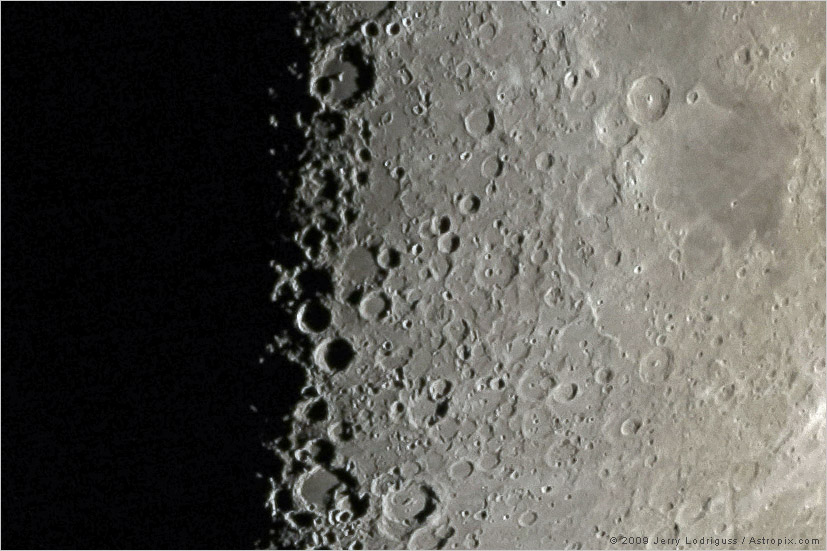
Unfortunately, the event frequently happens when the moon is below the horizon or while the sky is too bright. But this month, observers in the Americas can see easily spot the X! The shape will begin to develop by about 7 pm EDT (or 23:00 GMT) on Wednesday, October 9. At that time the moon will be shining in a twilit sky in easterly time zones in the Americas and in a bright sky in western time zones. The pattern will peak in intensity about an hour later and then disappear by about 9:45 pm EDT or 6:45 pm PDT. (Viewing a daytime moon through polarized glasses in a bright sky will increase the image contrast.)
During a Lunar X event, you can also look for the Lunar V and the Lunar L. The “V” is produced by combining the small crater named Ukert with some ridges to the east and west of it. It is located a short distance above the moon’s equator at lunar coordinates 1.5° East, 8° North. There is a very interesting-looking area on the moon just to the right (or lunar east) of the “V”. Under magnification, the little crater Hyginus is crossed by a bent rille (or trough). North of that is a large, horseshoe-shaped “scar” that geologists suspect was a volcanic caldera. (Your telescope may flip and/or invert the view.)
For a further challenge, see if you can see the letter “L” down near the moon’s southern pole. Its position is to the southwest of three prominent and adjoining craters named Licetus, Cuvier, and Heraclitus, which resemble Mickey Mouse’s head and ears. Some people claim they can see a letter-E on the moon during the Lunar X period, too. Then, by picking a round crater along the terminator to serve as the “O”, you can spell L-O-V-E! The patterns will be visible anywhere on Earth where the moon is shining, especially in a dark sky, between about 23:00 Greenwich Mean Time on October 9 and 02:00 on October 10.
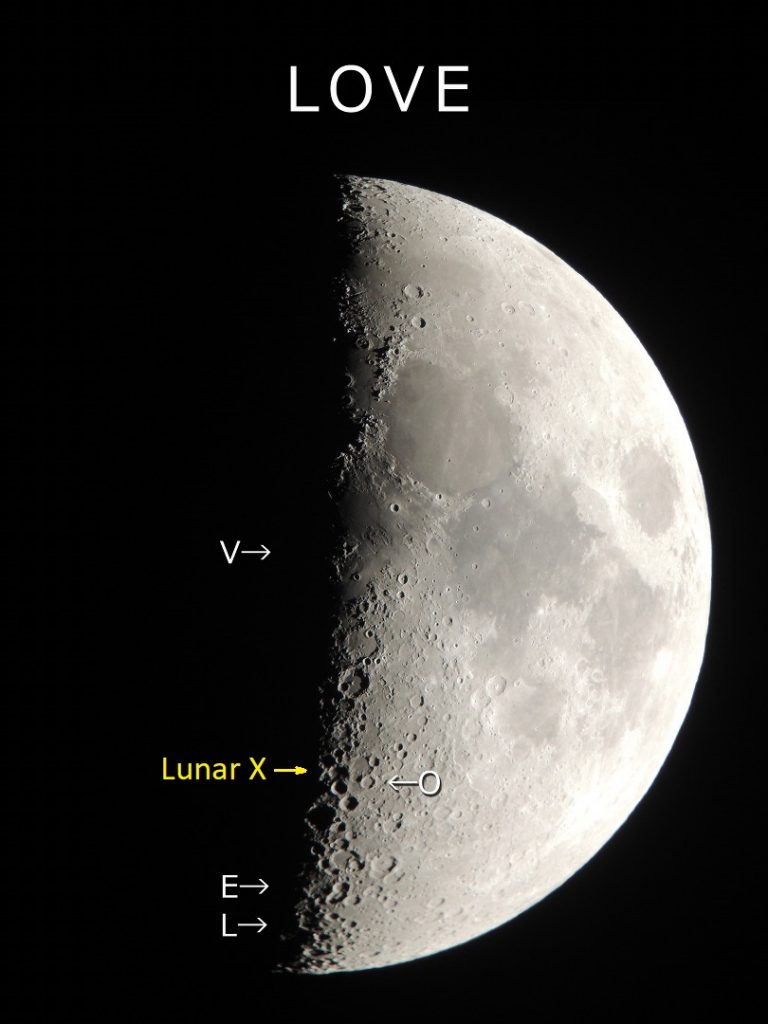
The moon will complete the first quarter of its journey around Earth on Thursday, October 10 at 2:55 pm EDT or 11:55 am PDT, which converts to 18:55 Greenwich Mean Time. At first quarter, the moon’s 90-degree angle from the sun will cause us to see it half-illuminated on its eastern side – the terminator now a straight line. The moon will shine to the left of Sagittarius’s stars after dusk and set around midnight. The moon is safe to look at in the daytime sky as long as you don’t point binoculars or a telescope over to where the sun is shining.
On Thursday night, the terminator will fall to the left (or lunar west) of Rupes Recta, also known as the Lunar Straight Wall. The rupes, Latin for “cliff”, is a north-south aligned fault scarp that extends for 110 km across the southeastern part of Mare Nubium, the dark patch in the lower third of the moon’s Earth-facing hemisphere. The wall is visible as a straight line in good binoculars and backyard telescopes. It is most prominent a day or two after first quarter, and also on the days before the third quarter phase. For reference, the prominent crater Tycho, with its central mountain peak, is located due south of the Straight Wall. Tycho will be a dark circle on Thursday and then a lit crater on Friday.

From Friday onwards, the moon will appear with a waxing gibbous, i.e., more than 50%-illuminated, phase. It will spend Friday and Saturday visiting Capricornus (the Sea-Goat) and then hop into next-door Aquarius (the Water-Bearer) next Sunday. Watch for the yellowish dot of Saturn shining off to the moon’s left that night.
On Saturday night, the terminator will fall cross Sinus Iridum, the Bay of Rainbows. The circular 249 km diameter feature is a large impact crater that was flooded by the same basalts that filled the much larger Mare Imbrium to its east – forming a rounded “handle” on the western edge of that dark mare. The “Golden Handle” effect is produced when sunlight strikes the prominent Montes Jura mountain range surrounding Sinus Iridum on the north and west while the floor of the bay remains dark. Sinus Iridum is almost craterless, but hosts a set of northeast-oriented wrinkle ridges that are revealed around this phase. I’ll post a photo of the Golden Handle here.

The Planets
Planet season continues! From now until February, we’ll have four planets to see in the evening, and two more from late-night to dawn. Mercury will enter the western post-sunset sky this week – but it won’t be easy to see unless you live close to the tropics or in the Southern Hemisphere. You don’t need a large aperture telescope to view planets – but you will need one with a long focal length (1,500 mm or more) if you want them to look nice and large.
Starting our tour after sunset, Venus is hard to miss if you know where and when to look for it. Nowadays, the planet is setting about 75 minutes after the sun for mid-northern latitude observers. Immediately after the sun has set, turn and face southwest and look low in the sky for a brilliant, gleaming white dot. Tonight (Sunday) the waxing crescent moon will shine a fist’s diameter to Venus’ left. (If you see something bright that is moving left or right, it’s an airplane.) Venus is returning from a trip beyond the sun, so it is simultaneously increasing its angle from the sun, waning in illuminated phase, and growing larger in telescopes. It’s not setting any later each night because its eastward orbital motion is counteracting the daily westward drift of the sky. This week Venus will set at about 8 pm local time.
Venus will be higher and easier to see for folks living closer to the tropics. No matter where you live, it will be safe to view it through binoculars or a telescope after the sun has completely disappeared. In a telescope the planet will show a blurry (due to the extra air you are looking through) 82%-illuminated disk – like an over-inflated rugby ball. In the early 1600’s, Galileo used his small spyglass to see that Venus exhibited phase and apparent size changes, and sketched what he saw. Sharp-eyed skywatchers long before the advent of telescopes likely noted the same thing.

As Venus sinks in the southwest, fainter Saturn will be rising in the southeast. The ringed planet passed opposition night a month ago, so it is rising in the east before sunset, crossing the southern sky all night long with the not-very-bright stars of Aquarius (the Water-Bearer) that are hosting it, and setting the west before dawn. You’ll get the clearest views of Saturn in a telescope after 8 pm, when it will be higher in the sky. Binoculars will show you a bent-line trio of stars collectively named Psi Aquarii sparkling to Saturn’s lower left. See if you can tell that the lower two are white, while the higher one is golden. Two redder stars named Phi and Chi Aquarii will appear to Saturn’s left and lower left, respectively.
Saturn’s extremely thin rings effectively disappear when they become edge-on to Earth every 15 years. They will do that in late March (while in the pre-dawn sky), so the rings already look like a thick line drawn through the planet. Good binoculars can hint that Saturn has rings. Any size of telescope will show the rings and some of Saturn’s larger moons. In most years, Saturn’s moons are spread all around the planet – unlike Jupiter’s Galileans moons, which are always in a line – but Earth’s perspective of the Saturn system this year and next year is making its moons line up with the rings.
Saturn’s largest and brightest moon Titan never wanders more than five times the width of Saturn’s rings from the planet. The much fainter moon named Iapetus “eye-YA-pet-us” can stray up to twelve times the ring width during its 80-day orbit of Saturn. The next brightest moons Rhea “REE-ya”, Dione “Dee-OWN-ee”, Tethys “Teth-EES”, Enceladus “En-SELL-a-dus”, and Mimas “MY-mass” all stay within one ring-width of Saturn. You may be surprised at how many of those six you can see through your telescope if you look closely when the sky is clear, dark, and calm.
During this week, Titan will move from far to Saturn’s upper right (or celestial west) tonight, pose closely above Saturn on Friday, and then to down to the lower left of Saturn (or celestial east) on the coming weekend. (Remember that your telescope will probably flip the view around.) The rest of the moons will be tiny specks in a line near the rings. Earth’s perspective of the Saturn system will also cause Saturn’s moons and their small black shadows to frequently cross its disk – but you’ll need a very high quality telescope to watch those.
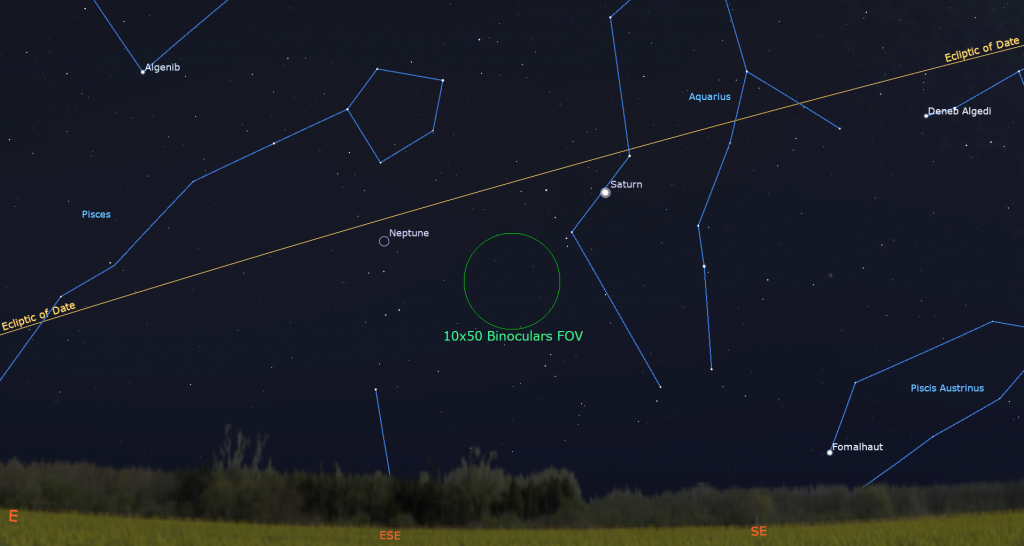
Saturn is being followed across the sky every night by the distant blue Neptune – but viewing that planet requires a large pair of binoculars or a decent backyard telescope. This week Neptune will rise half an hour before sunset and be visible all night long. For the best views, wait until it’s higher up after about 9 pm local time. Slow-moving Neptune will spend all of this year in western Pisces (the Fishes). During evening it’s about 1.4 fist widths to the lower left (or 14° to the celestial ENE) of Saturn and a palm’s width below the circle of stars that forms Pisces’ western fish. Use binoculars to find the upright rectangle formed by the medium-bright stars 27, 29, 30, and 33 Piscium. Neptune will be the bluish, dull “star” sitting about two finger widths above (or 2° celestial north of) that box.
For the late-evening planet-watchers, blue-green Uranus will rise in the east around 8:20 pm local time along with the bright little Pleiades star cluster in Taurus (the Bull). Slow-moving Uranus will stay about a palm’s width to the Pleiades’ right (or celestial south) until 2027! Uranus will become high enough for viewing in binoculars or a backyard telescope after 11 pm, and highest, due south, around 3 am – but those times will advance every week. To get you in the vicinity of Uranus, look for the bright star Menkar shining 2.2 fist diameters to the right of the Pleiades. Uranus will be on the line joining the bottom star of the Pleiades to Menkar.
If you are awake after 11 pm, you’ve probably spotted brilliant Jupiter climbing the eastern sky every night. It actually shines prominently through one of our windows! The planet will rise just before 10 pm local time and climb to a point very high in the southwest in time for you to see it at sunrise. (Like Uranus, Jupiter will show up about 30 minutes earlier every week.) The largest planet will wander between the horns of Taurus (the Bull) for the next few months and shine about a fist’s width to the left (or 12° to the celestial ENE) of the bull’s brightest star, reddish Aldebaran.
On Wednesday, October 9, the eastward prograde motion of Jupiter will slow to a stop. Beyond that night, Jupiter will accelerate into a westward retrograde loop that will last until early February. Retrograde loops occur when Earth, on a faster orbit closer to the sun, passes distant planets “on the inside track”, making them appear to move backwards across the stars for a period of time. You can notice Jupiter’s motion over the coming weeks by comparing its position to the bright horn-tip stars Elnath and Zeta Tauri to its upper left and lower left, respectively.
Any binoculars will show Jupiter’s four Galilean moons named Io, Europa, Ganymede, and Callisto lined up beside the planet. Those moons complete orbits of the planet every 1.7, 3.6, 7.2, and 16.7 days, respectively. If you see fewer than four moons, then one or more of them is crossing in front of or behind Jupiter, or hiding in Jupiter’s dark shadow – or two of the moons are very close together, or one moon is eclipsing or occulting another one.
Even a small, but decent quality telescope can show you Jupiter’s dark belts and light zones, which are aligned parallel to its equator. With a better grade of optics, Jupiter’s Great Red Spot, a cyclonic storm that has raged for hundreds of years, becomes visible for several hours when it crosses the planet every 2nd or 3rd night. For observers in the Americas, that GRS will cross Jupiter’s disk late on Tuesday, Thursday, and Saturday night, and before dawn on Monday, Wednesday, and Saturday morning. If you have any coloured filters or nebula filters for your telescope, try enhancing the spot with them.
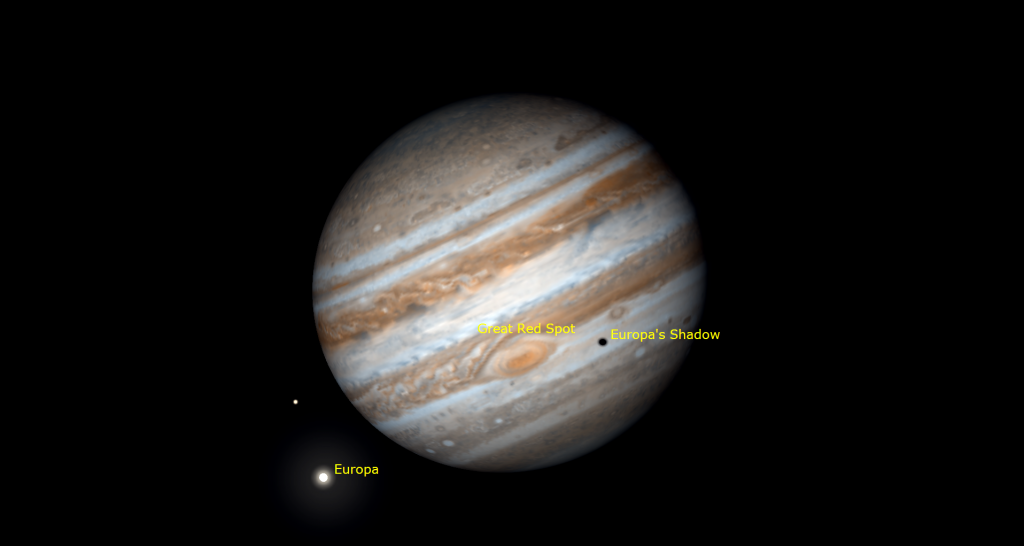
From time to time, observers with good quality telescopes can watch the black shadows of the Galilean moons travel across Jupiter’s disk. In the Americas, the small shadow of Europa and the great red spot will cross near Jupiter’s equator on Thursday morning, October 10 between 2:28 am and 4:55 am EDT (or 06:28 to 08:55 GMT).
While Mars will be rising before midnight local time from now on, your best bet for seeing it will be while it’s reddish speck is shining very high in the southeastern sky around 6 am local time. Search about 2.7 fist diameters to Jupiter’s lower left (or celestial east). Mars’ relatively faster orbital motion will increase its separation from Jupiter a little more each morning. If you are under the stars before morning twilight, you’ll notice the bright winter constellations (Auriga, Taurus, Gemini, Orion) surrounding Jupiter. At the end of October, Mars will escape Gemini’s embrace and enter Cancer (the Crab) for a spell.

Mars will become hidden by the morning twilight long before brilliant Jupiter does. In a telescope, the red planet will appear as a small, ochre disk. Its position on the far side of the sun from Earth, 179 million km from Earth and closing, will keep the planet looking small until later this year. This week, Mars will only be 88%-illuminated because its angle from the sun is 86°.
Meteor Watch
The early setting moon this week will allow us to keep an eye out for early shooting stars from two showers that are approaching their peak nights. The Orionids will build to a peak on October 20-21, and the Southern Taurids will reach its maximum on November 4-5. In both cases the meteors will appear to streak away from (or radiate) from the eastern sky, where those two constellations will rise late at night.
Cygnus Soars Overhead
If you missed my in-depth tour of the great constellation Cygnus (the Swan), I posted it here.
Public Astronomy-Themed Events
Every Monday evening, York University’s Allan I. Carswell Observatory runs an online star party – broadcasting views from four telescopes/cameras, answering viewer questions, and taking requests! Details are here. They host in-person viewing on the first clear Wednesday night each month. Other Wednesdays they stream views online via the observatory YouTube channel. Details are here.
Taking advantage of the crescent moon in the sky this week, the RASC Toronto Centre astronomers will hold their monthly City Sky Star Party in Bayview Village Park (a short walk from the Bayview TTC subway station), starting after dusk on the first clear weeknight this week (Mon, Tue or Thu only). Check here for details, and check the banner on their website home page or Facebook page for the GO or NO-GO decision around 5 pm each day.
Eastern GTA sky watchers are invited to join the RASC Toronto Centre and Durham Skies for solar observing and stargazing at the edge of Lake Ontario in Millennium Square in Pickering on Friday evening, October 11, starting at 6 pm. Details are here. Before heading out, check the RASCTC home page for a Go/No-Go call – in case it’s too cloudy to observe.
On Saturday, October 12 from 8:30 to 10:30 pm, RASC Toronto Centre will celebrate International Astronomy Day 2024 at their Family Night at the David Dunlap Observatory for visitors aged 12 and up. You will view celestial sights through RASC telescopes if the sky is clear. This program runs rain or shine. Details are here, and the link for tickets is at ActiveRH.
Space Station Flyovers
The ISS (or International Space Station) will not be visible gliding silently over the Greater Toronto Area this week.
Keep your eyes on the skies! I love getting questions and requests. Send me some!